The 8 pads are responsive and backlit, offering velocity and pressure sensitivity adjustments. The device is shipped with Analog Lab Lite, Ableton Live Lite, and UVI Grand Piano music production platforms. The touch controls provide the modulation wheel and enable pitch blending.
The white housing is easily soiled.
Not-weighted, full-size keyboard, 25 keys
Velocity and pressure sensitivity
USB
2 banks of 8 pads with RGB backlighting, 16 rotary encoders (2 of them are clickable), 2 capacitive touch sensors for pitch bend and modulation wheel, 8 user presets, octave up and octave down buttons
USB port, sustain pedal, MIDI out, Kensington security slot
Mac or PC compatible, comes with 3 software titles
35.6 x 22.9 x 3.8 cm
1.5 kg
30 days
In addition to the keyboard, you receive the most comprehensive software suite, free online lessons, and >60 app-based lessons. The octave range buttons will allow you to extend the cords, bring lead lines, and add sub-heavy basslines. The semi-weighted keys are offering an authentic response.
The initial setup takes quite some time.
The M-Audio Keystation 49 MK3 will enable sequencing music, playing different virtual musical instruments, and performing knowing the keyboard can capture every nuance and offers you the tools and the controls to add these nuances, creating complex, multi-layered music.
Semi-weighted, full-size keyboard, 49 keys
Velocity sensitivity
USB
Directional pad (up, down, left, right, and enter), pitch and modulation wheels, fader, buttons, pitch and mod wheels to control any DAW or plugin parameter
USB port, sustain pedal, MIDI out
Compatible with Mac, PC, and iOS devices via the Apple-to-USB camera adapter (sold separately), premium software suite included, includes free online lessons from Skoove and over 60 app-based lessons from Melodics
82.19 x 18.89 x 6.80 cm
2.14 kg
1 year
Though not weighted, the keys are velocity-sensitive, so how hard you press them will determine how loud the sound will come out. You'll be able to send program changes through the 49 keys. The sustain pedal input will enable adding genuine piano-esque sustain.
The keys feel too springy.
The Alesis Q49 is a MIDI keyboard that will accommodate both beginners and experienced musicians looking to use professional DAWs and music production platforms to not only perform but also sequence and record music. The device is compatible with Windows, Mac, and iOS.
Not-weighted, full-size keyboard, 49 keys
Velocity sensitivity
USB, AC (optional)
Pitch and modulation wheels, backlit octave up and down buttons, assignable volume/data-entry slider
USB port, sustain pedal, MIDI out
Compatible with Mac, PC, and iPad via the Apple-to-USB adapter (sold separately), Xpand!2 by AIR Music Tech, and Ableton Live Lite software included
81.28 x 17.78 x 5.71 cm
2.27 kg
2 years
The 25 synth-action velocity-sensitive keys will enable playing chords, pads, basslines, and even lead parts. The six-button layout, including the arpeggio steps, tap tempo controls, the sustain button, and the octave controls, will allow you to tap the tempo, sustain the notes, and access programmed functions.
The case feels cheap.
The Akai Professional LPK25, measuring ~34 x 10 x 3 centimetres, fits inside any backpack and even most laptop cases and messenger bags. Thanks to its 450-gramme weight, you'll barely be feeling its presence yet the keyboard will let you create the most elaborate melodic and harmonic riffs with ease to match.
Semi-weighted, full-size keyboard, 25 keys
Velocity sensitivity
USB
Arpeggiator, sustain button, octave up and down and tap tempo controls, 4 programmable memory banks
USB port, MIDI out
Plug-and-play connection for Mac and PC, comes with editor software for Mac and PC
34.03 x 9.65 x 2.79 cm
0.45 kg
1 year
The Pro Tools First interface is not very intuitive.
The M-Audio Keystation Mini 32 MK3 is an excellent MIDI keyboard when you take its price, size, and weight into account. Plus, the company's premium software suite lets you get started right away, composing, remixing, editing, and recording music anywhere you go.
Not-weighted, full-size keyboard, 32 keys
Velocity sensitivity
USB
Octave up and down buttons, volume knob, sustain button
USB port, MIDI out
iOS compatibility using the Apple iPad Camera Connection Kit (sold separately), premium software suite included
41.75 x 10.66 x 1.82 cm
0.45 kg
1 year
This site is a free online resource that strives to offer helpful content and comparison features to its visitors. Please be advised that the operator of this site accepts advertising compensation from certain companies that appear on the site, and such compensation impacts the location and order in which the companies (and/or their products) are presented, and in some cases may also impact the scoring that is assigned to them. The scoring that appears on this site is determined by the site operator in its sole discretion, and should NOT be relied upon for accuracy purposes. In fact, Company/product listings on this page DO NOT imply endorsement by the site operator. Except as expressly set forth in our Terms of Use, all representations and warranties regarding the information presented on this page are disclaimed. The information which appears on this site is subject to change at any time. More info
Arturia MiniLab MKII
Great-Feeling Keybed
The Arturia MiniLab Mkill has been described as an essential tool that musicians on the move need and that facilitates studios where workspace is limited. At the very least, you can immediately tell where the second sentiment is coming from, looking at this device that measures no more than 355 x 220 x 50 millimetres. Despite its modest size though, the keyboard is brimming with features, enabling you to play, tweak, tap, and twist its rugged controls, breathing new life into old sounds. Everything here has been designed and added to streamline the creative process and aid creative minds.
For starters, using the 16 multi-function knobs, you'll be automatically putting important sound-shaping parameters in the Analog Lab app and the Ableton Live software that's also offered with the device. Also, you'll be able to map these knobs to any MIDI control software you like.
In addition to these knobs, the keybed adopts 25 slim-keys, 8 pads, and 2 touch controls, all crammed into its space-saving package. The knobs will double as rotary encoders, whereas the pads will allow you to adjust velocity and sensitivity levels. The touch controls are there to enable pitch blending and support the modulation wheel.
In other words, from experimenting with the bassline to tapping out solid drum beats to tweaking the synth patch's parameters, you're offered the freedom to control, manage, and manipulate the music without limitations.
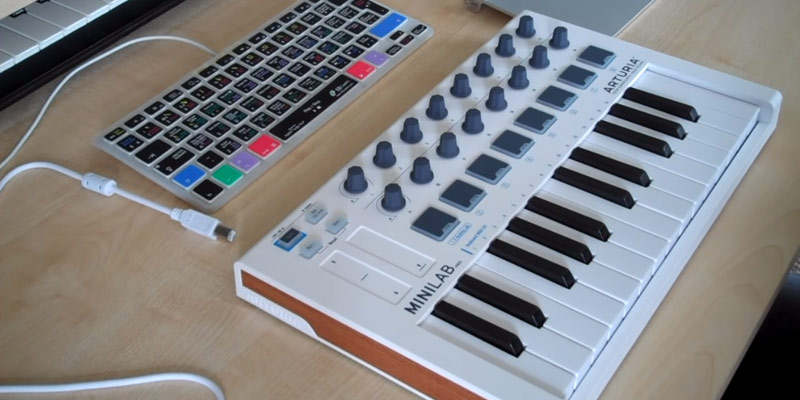
Full Control from Inception to Completion
Again, the keyboard looks quite modest, and its white housing is easily soiled. Despite its tiny footprint though, the device is rugged and durable enough to take the strain that comes from living life on the road, ready to perform night in, night out.
Still, you can make an argument that the keyboard is as valuable as the Ableton Live Lite software that the 'board is packaged with. Using this music production platform, you'll be transforming the most ambitious musical ideas into fully-fledged, pro-sounding recordings. The software automatically assigns controls using dedicated pre-mapping tools, allowing you to waste less time navigating the settings and spend more time creating music. You'll be adjusting the track levels, tweaking filters, and customising effects via the knobs, accessing the launch clips, capturing drum performance, and controlling the playback using the pads.
Bottom line, from the tune's inception to completion, the Arturia MiniLab Mkill makes sure that you remain in charge, controlling every step of the way.
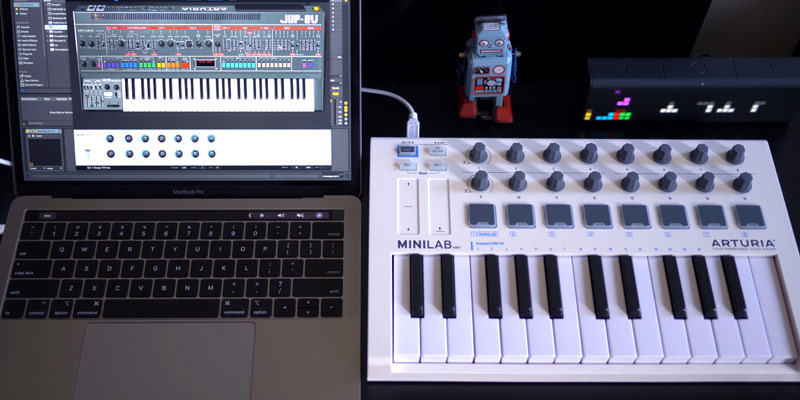
Additional Info
| Last updated price | £74.50 |
| Stock | In stock |
| ASIN | B01MSNIVKE |
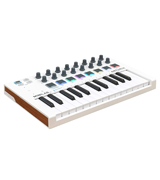
M-Audio Keystation 49 MK3
Ultimate Expression
The M-Audio Keystation 49 MK3 is not the smallest keyboard we have seen, we can start there. The model's iconic predecessor has been referred to as the ultimate expression and this device follows suit, adopting 49 full-size velocity-sensitive keys that not only ensure the most natural feel but also allow you to capture every subtle nuance.
Among these keys, you'll find the expertly-located octave range buttons that will let you manipulate the lead lines, extend the cords, and product sub-heavy basslines. Aside from that, the device features volume faders, giving you deep control of the plugins.
To add more, there are transport and directional buttons. Using these buttons, you'll be able to control any DAW/recording software. You can also customise the fader, pitch, modulation wheels to manipulate any digital audio workstation and any plugin parameter.
From the layout perspective, the modulation wheels and the pitch have been designed pretty ergonomically so that you can use them to command virtual instruments, including portamento, vibrato, any parameter that you have mapped to the mod wheel.
The initial setup will require you quite some time, this is what everyone's complaining regarding this MIDI keyboard but that also somewhat means that the device is devoid of major flaws.
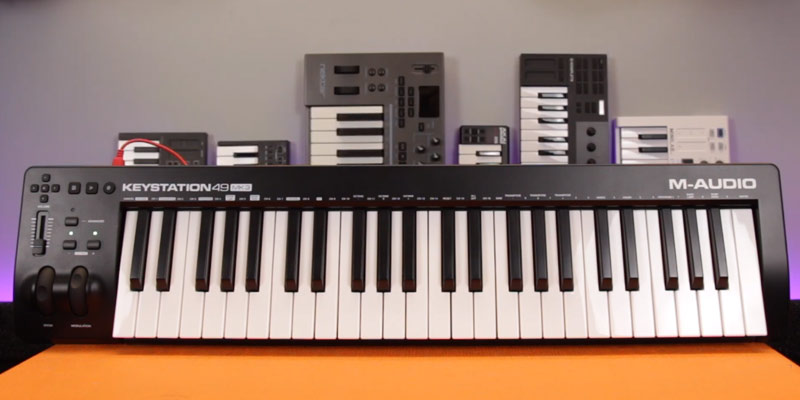
Capturing Every Nuance
Different DAWs can be difficult to manipulate sometimes. Here, thanks to the easily-accessible play, stop/record controls, and directional buttons, you'll be experiencing an unparalleled, streamlined recording workflow, through the included premium software suite. The suite offers the first M-Audio Edition, Ableton Live Lite, and multiple DAWs. In the meantime, the AIR Music Tech Mini Grand will provide seven acoustic piano sounds, whereas the AIR Music Tech Velvet will give you access to the virtual electronic piano that features five legendary electric pianos from the 60s and 70s. Besides these tools, the product is packing free online lessons from Skoove and more than 60 app-based lessons from Melodics.
Via its USB port, the keyboard is compatible with Mac, PC, and iOS devices, though the latter will have to be connected through the Apple-to-USB camera adapter that's sold separately. On the bright side, even with iOS devices, no drivers are required to make the 'board work.
Long story short, the M-Audio Keystation 49 MK3 will allow you to sequence music, play virtual musical instruments, and, before anything else, perform knowing that the device will be capturing every nuance.
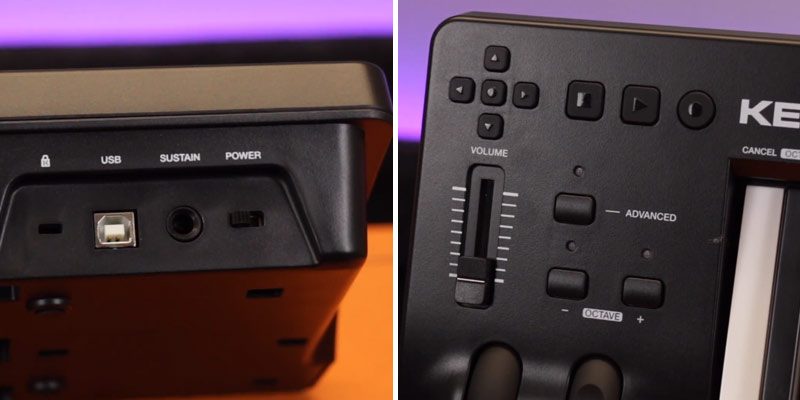
Additional Info
| Last updated price | £71.00 |
| Stock | In stock |
| ASIN | B07DDN6TP6 |
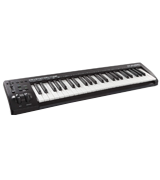
Alesis Q49
An Assignable Slider
Despite its humble beginnings, the Alesis Q49 can compete with premium keyboards.
Sure, the device has its shortcomings too. First, the keys are not weighted, so some might find them too springy. Now, they're velocity-sensitive though, meaning that the harder you squeeze these keys, the louder the sound will be.
Second, size- and weight-wise, the keyboard measures 813 х 190 х 63 millimetres and 2.27 kilogrammes, which is not that different from most 49-key MIDI 'boards but we have seen more lightweight and compact packages before, so improvements on this front would be welcome next time.
Still, between the pitch and modulation wheels, the octave up and down buttons that has also been backlit here, and the assignable volume/data-entry slider, you're offered everything you need to express yourself through music. Apart from standard applications, you can send program changes via these keys, controlling different digital audio workstations and music production platforms. Plus, the above-mentioned slider will give you core keyboard control and complete command over the virtual instrument collection. The keyboard even adopts sustain pedal input so that you're able to add authentic piano-style sustain, though you'll have to purchase the pedal separately.
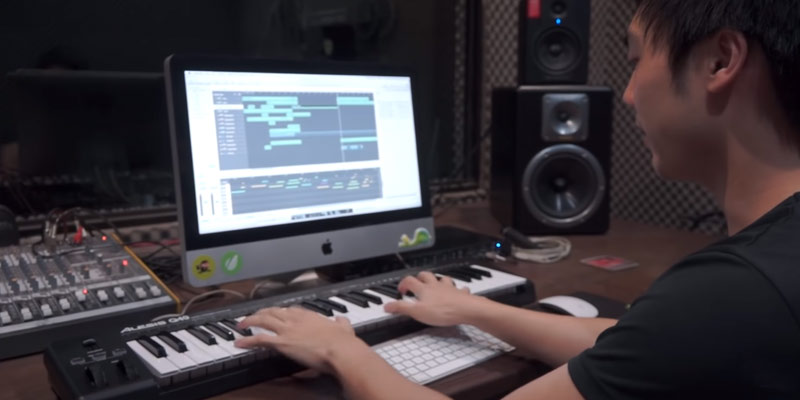
The Music Production Platforms
To some extent, you're buying copies of Xpand!2 by AIR Music Tech and Ableton Live Lite software as much as you're buying the keyboard here.
The first software offers sounds galore, offering everything from basic wavetables and standard FM synthesis to sample playbacks. You can easily browse parts and sort them into 29 categories. Featuring six smart knobs, the software lets you custom-tweak the sounds, with each knob changing its function depending on the selected part. You'll be able to assign the pitch bend wheel and pressure modulation independently for different parts. Besides that, the platform allows you to synchronise the modulation rates by tempo or go with the free-wheeling approach. You're provided countless modulation destinations, with WAVE destination parameters different from part to part, shaping the sound and sequencing music without breaking any sweat.
The Ableton Live Lite software requires no such introductions and descriptions though, giving you the tools to adjust the filters, tweak track levels, customise sound effects, capture the drumming performance, and access the launch clips.
To put it differently, the Alesis Q49 is an excellent intermediary between the musician and music production platforms that, using this MIDI keyboard, lend you the tools to perform, record, and sequence music.
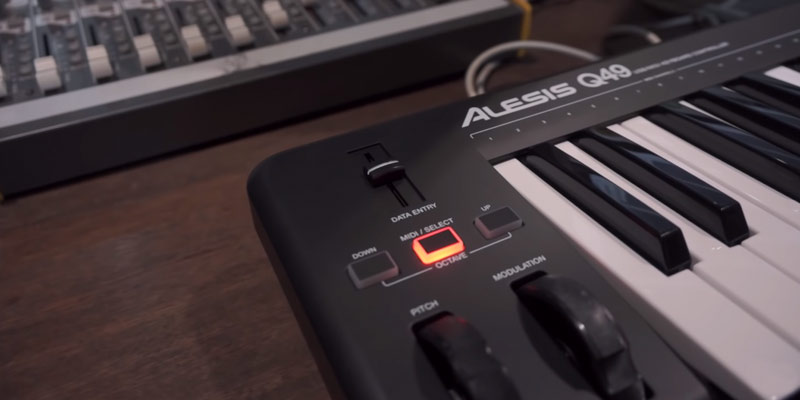
Additional Info
| Last updated price | £128.99 |
| Stock | In stock |
| ASIN | B0038YX3BS |
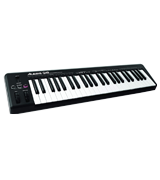
Akai LPK25
The Arpeggio and the Sustain Too
The Akai Professional LPK25 is tiny. Its ultra-compact profile barely reaches 340 x 97 x 28 millimetres. Plus, the keyboard weighs less than 0.5 kilograms (450 grammes, to be precise), so you can fit this device inside most backpacks, laptop cases, and even messenger bags without even feeling that it is there.
Nonetheless, the device offers 25 synth-action velocity-sensitive keys, letting you play chords, pads, basslines, and lead parts. Because the keys are semi-weighted, the feel is authentic and natural, recreating the sensation you experience when pressing piano keys.
See, measuring less than 13 inches (34 cm) across, you're not expecting the keyboard to pack enough features to produce layered music. Yet, these expectations, whilst reasonable, prove false. Though designed as a scaled-down relative to the MPK series, this device is packing more than most 49-key 'boards, including onboard arpeggiator steps, a sustain button, tap tempo controls, and the standard octave up and down buttons.
The arpeggiator will be automatically stepping through chords automatically, enabling musicians to create quick yet inspired melodies. When the ARP (arpeggio) is turned on, you can hold down the button down and set the mode, the arp time-division (between 1/4 and 1/32T) and the octaves from 1 to 4. Using the rest, you'll be able to sustain notes, tap the tempo, and call programmed functions. To sum up, this six-button layout to the device's left is easy to learn and ergonomic enough to streamline the workflow.
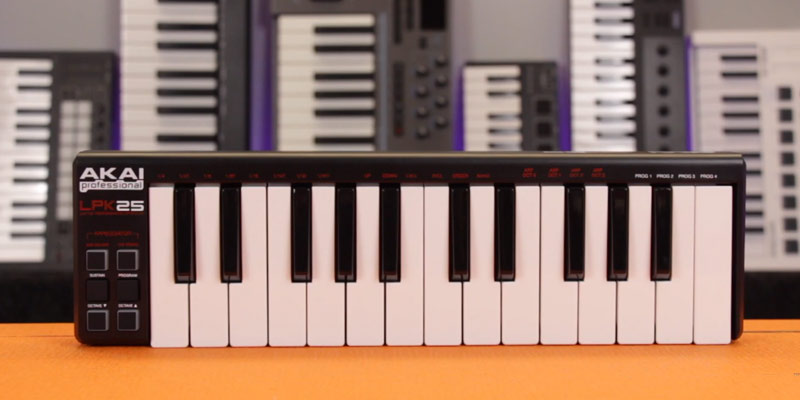
Programmable Memory Banks
Packing so much into the device's modest footprint yet keeping the price more than reasonable comes with its sacrifices, unfortunate but that's the way the cookie crumbles. Before anything else, the plastic case feels cheap, which some will find negligible but is somewhat upsetting nonetheless because, from every other perspective, the keyboard does not disappoint.
In addition to the controls that we have reviewed above, the device comes equipped with 4 programmable memory banks that enable instant recall of mappings for digital audio workstations, virtual instruments platforms, different effects, and more, meaning that you won't be wasting time customising the controls every time you start using new software. Also, to go with the keyboard, you receive editor software for Mac and PC.
To conclude, the Akai Professional LPK25 allows you to create intricate melodic and harmonic riffs within seconds, anywhere, anytime.
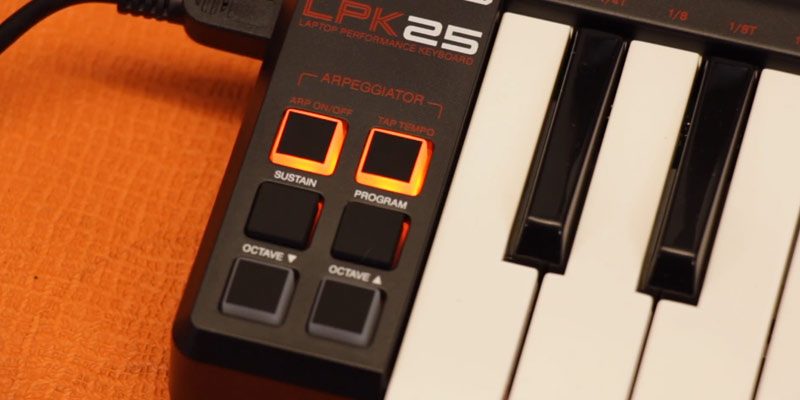
Additional Info
| Last updated price | £45.12 |
| Stock | In stock |
| ASIN | B002M8GBDI |
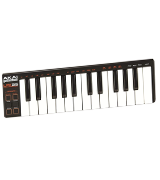
M-Audio Keystation Mini 32 MK3
Customisable Response
The M-Audio Keystation Mini 32 MK3 starts with its slimline footprint. Before we can review its features and everything, we need to establish that the device measures 418 millimetres length-wise and 107 millimetres width-wise, so we're not talking about the biggest keyboard, hence its 32-key layout and somewhat reduced feature list. Now, the 'board has its moments, we're not claiming the opposite.
To begin with, the device lets you customise the response, which's huge, something that even premium models are seldom offering. You can select the velocity curve, matching different playing styles, including traditional pianos, synthesisers, and key-based beat-making machines. Aside from that though, this keyboard appears somewhat pedestrian, not leaving much to be desired but also not impressing from most perspectives.
Sure, the pitch bend and modulation buttons are great, adding expression to the music you're sequencing. But the seven-button layout is pretty cramped, so accessing these buttons proves inconvenient at times. Besides pitch and modulation, the layout adopts the sustain button and two octave buttons, extending the keyboard's range. Above this layout, you'll find the volume knob, delivering smooth control when editing the music. Long story short, the controls are simple yet pretty comprehensive. To the left, there's the USB port that allows connecting the device to computers.
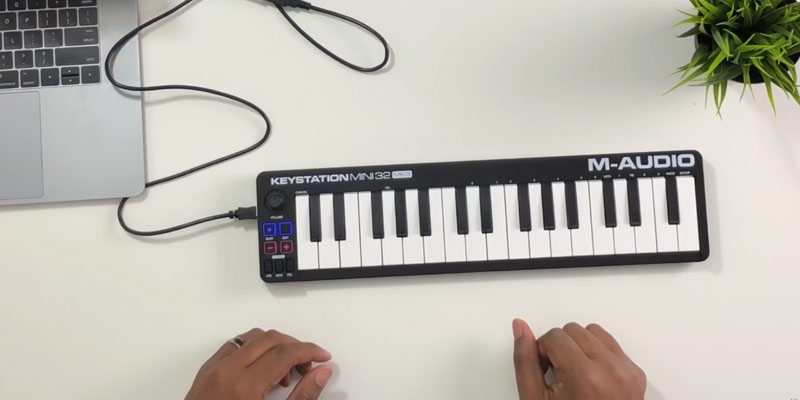
Premium Software Suite
Besides its modest dimensions size-wise, the keyboard's weight caps at 450 grammes, meaning that you can easily bring this device with you from home to the studio and to the gigs.
What's more important is that M-Audio MIDI keyboards are always sold with premium software suites. Here, you'll have access to Ableton Live Lite, the digital audio workstation that producers use across the world. Its audio interface will let you compose, remix, edit, and record anything that the MIDI environment can provide.
Apart from that, the product offers access to Pro Tools First, the recording software that lends you unlimited basses, elastic time, elastic pitch, offline bounce, and free (1 gigabyte) cloud storage space, allowing you to collaborate with different artists and access the projects from anywhere. Some find the app's interface a little counterintuitive but, with time, you'll get used to it.
Bringing this home, the M-Audio Keystation Mini 32 MK3 is all about giving you the tools to create in any environment: at home, on the road, at the gigs, and more.
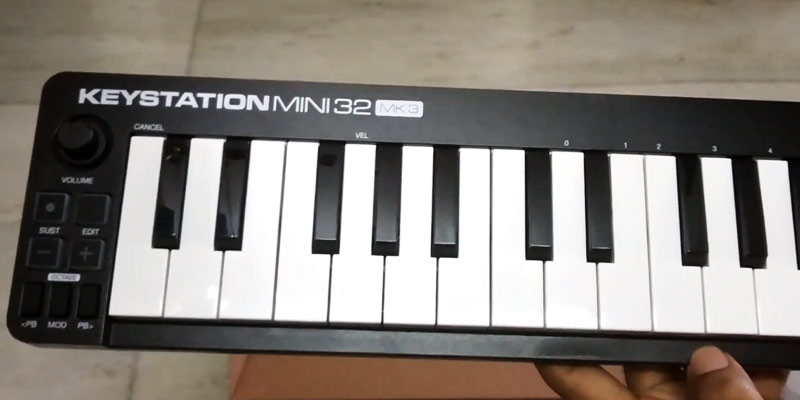
Additional Info
| Last updated price | £39.00 |
| Stock | In stock |
| ASIN | B07GBNNF23 |
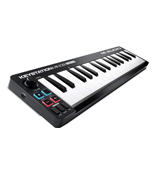
What Is a MIDI Keyboard?
Not every musician can afford or has the space for a full-sized piano. Even so, with the advances in music technology, full-sized pianos are becoming a thing of the past for homes. Electronic keyboards have been around for decades now, and they have only become better and better as the march of technology has allowed them to become more complex whilst being able to imitate acoustic musical instruments to near precision. This is just fine, though, as electronic keyboards on the whole are much more affordable than real pianos, take up much less space, yet are far more useful than as a singular musical instrument.
MIDI technology, which has also been around for decades, has allowed for electronic instruments to interface with computers. Even though this technology is quite old, many musicians still prefer using a MIDI interface (as opposed to newer USB interfaces) due to the accurate timing that many MIDI adapters have. As such, anyone who is serious about using a keyboard for composing and arranging music on their computer will most likely want to connect it through a MIDI adapter.
If you are interested in using your computer for recording music, you may want to look into getting one of the best recording microphones.
What Features to Compare
Whether you are a complete newbie to electronic keyboards, or a seasoned professional, there are a large number of characteristics that one should be aware of when choosing the best MIDI keyboard for your home studio. MIDI keyboards can vary greatly depending on their capabilities, built-in features, and even on the physical dimensions of the device, so it is important to know what you look for. Below are some of the most important characteristics to pay attention to with any MIDI keyboard that you wish to purchase.
Keyboard
The physical characteristics of the keyboard itself are important to note, as they can vary greatly. Many keyboards range from a limited number of keys all the way towards a full size 88 key layout. Furthermore, the keys themselves should be important to note. Keys that are weighted with a hammer action are much more like playing on a real piano, whilst those with no hammer action and only semi-weighted will feel more artificial. Whichever types of keys you find more suited to your playing style, you will want to make sure that the keyboard you choose has them.
Sensitivity
A keyboard's key sensitivity can also be an important factor when choosing the right keyboard. Key sensitivity denotes how the keyboard responds or plays notes based on how hard the key is pressed, with some keyboards offering a greater sensitivity than others. Those who prefer keyboards with a high degree of key sensitivity will want to choose a model that matches their preference.
Power Source
The power source of a MIDI keyboard is something that everyone should factor into their decision regarding which model to choose. Whilst many older MIDI keyboards of the past were simply limited to running from an AC adaptor plugged into a power outlet, there is a bit more choice now. Many of the MIDI keyboards reviewed here can actually be powered by batteries, with some even supporting power through a USB connection. Be sure to check the power source of any MIDI keyboard that you buy to make sure it will fill your needs.
Controls
Most MIDI keyboards have a variety of controls that let you take advantage of the different features and abilities offered by the device. Most keyboards at minimum will have buttons that control certain functions, whilst some may even have their own LCD screen that will display various information that makes choosing the different functions an easy process.
Interfaces
Any MIDI keyboard needs a variety of interfaces to meet the needs of its user. Most MIDI keyboards by default will have MIDI ports available, with most recent models also including USB ports. Still, other interfaces may be required by the user, such as ports for connecting various pedals as well as even headphones for silent playing. Whichever keyboard you choose, make sure it has all of the interfaces that you need.
Did you know?
MIDI Controllers vs Keyboards
After reading through the reviews, you have probably noticed two different terms used for the different products that have been reviewed. Some devices are referred to as MIDI keyboards, whilst others are referred to as MIDI controllers. Is there a difference between these two types of devices, and if so, what are they? Indeed there are differences, and it is very important for someone in the market for a keyboard to know what these differences are. Below we will explain the capabilities of each device and what they are best used for.
MIDI Keyboard
Electronic keyboards have been around for decades now, and MIDI keyboards are essentially just extensions of those. These are stand-alone musical instruments that usually include a variety of different sounds that let you play them as a substitute for acoustic instruments. A MIDI keyboard doesn't have to be connected to any other device in order to be used. However, the "MIDI" part of the name comes in with their capability to interface with a computer or another MIDI device. This lets you use the keyboard either as its own device, or as a method of composing music directly on your computer, giving you an easy way to save your new musical ideas instantly. MIDI keyboards may or may not have a MIDI controller built-in, so their capabilities with a DAW (Digital Audio Workstation) will vary depending on the exact keyboard used.
MIDI Controller
Unlike a MIDI keyboard, a MIDI controller is not a stand-alone device, as it does not contain its own ability to play sounds. Instead, it needs to be connected to a computer or to another MIDI device in order to attain that capability. MIDI controllers, therefore, are generally geared much more towards composition than towards general playing. In fact, many MIDI controllers, especially the portable kind, will not contain a full 88 key keyboard, with some devices only having a single octave's range of keys available. Instead, MIDI controllers will often feature a variety of controls that give you a great amount of capabilities in driving a Digital Audio Workstation on a computer, including the ability to heavily control the sounds produced through the external source. In short, a MIDI controller absolutely needs an external source in order to play sounds, but it also gives you a great deal of capability in controlling and editing those sounds directly from the device.
Which One Should I Buy?
Some people may still be a little confused about which devices they should buy, even after reading the differences between MIDI keyboards and MIDI controllers. Really, the differences will heavily dictate what they can be used for, and which device you should buy will depend greatly on how you want to use it. If you are looking for a device for playing music, especially for some kind of live performance, and you don't want to have to use a computer along with it, a MIDI keyboard is what you need. However, if you are looking more towards composing and recording your own music, then you will be better off with a MIDI controller. Whichever one you choose, though, will give you a far more powerful and capable musical instrument than what you've ever had before!
Popular Comparisons
































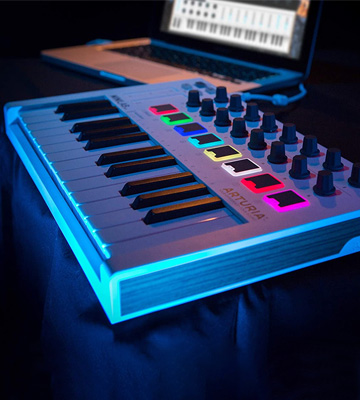
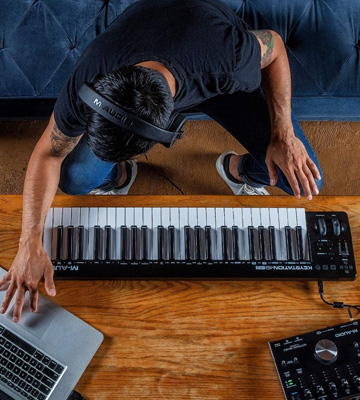
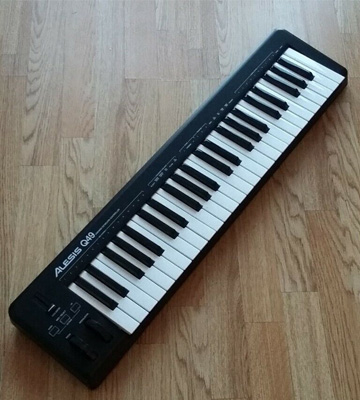
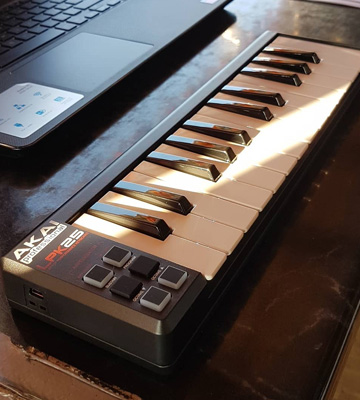
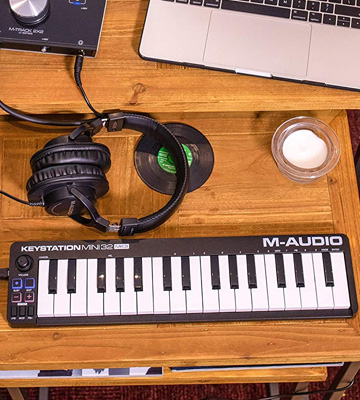
Your comment was successfully sent
Error! Please try again later